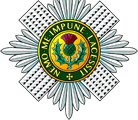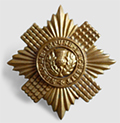From 1793 Britain was at war almost continuously till 1815 with, first, Revolutionary France, and, later, the French Empire under Napoleon. From early on the Scots Guards were engaged in operations in Flanders and on the Dutch coast, several of them both questionable in concept and also badly planned and executed. From time to time there was a marked success including the outstanding minor battle near Lille in 1793 which led to the Battle Honour “LINCELLES”. After Admiral Nelson’s crushing victory in 1798 over the French fleet in the Battle of the Nile there were still French troops in Egypt and for the time being, in the light of the rise of Napoleon’s star on mainland Europe, opportunities for British land operations were restricted to the periphery and in particular in the Mediterranean. Lieutenant General Sir Ralph Abercromby, very thorough and careful, commanded the expedition, the Scots Guards amongst them, which landed near Alexandria in 1801. The French were completely defeated, but General Abercromby died of wounds. The Scots Guards were awarded “THE SPHINX” superscribed “EGYPT”, the first Battle Honour to be emblazoned on the Colours. It was at this time that the French began to decorate their regimental colours with battle honours and the British took up the practice. There was one other interesting and successful operation in which the Scots Guards took part, the 1807 naval and military expedition to Copenhagen to secure the surrender of the Danish fleet, which it was feared might otherwise fall into Napoleon’s hands. The military commander was Major General Sir Arthur Wellesley, on whose staff was Lieutenant Colonel George Murray of the Scots Guards.
Because of his victories on the European mainland in 1809 Napoleon was almost in a position to close down all British trade with the Continent and because of his, admittedly shaky, domination over Spain had in mind the capture of Gibraltar and the closing of the Mediterranean to the British as well. However, when he ordered Portugal to ban the British from her harbours he met with a refusal. There were Spanish requests for assistance too. The British Government agreed to send a small force to Portugal under Sir Arthur Wellesley and so began the Peninsular War. The 1st Battalion Scots Guards was in reinforcements landing in Lisbon in March and very soon afterwards Sir Arthur Wellesley arrived to take command with Colonel George Murray in the role of Chief of Staff, a very sound partnership. From here on Sir Arthur Wellesley, later Duke of Wellington, gradually wore down a succession of French generals, as their armies were impeded by Napoleon’s other schemes, including the invasion of Russia in 1812, while the rising confidence of Spanish guerrilla bands strangled French communications and ensured a steady flow of reliable information to the British. All along Wellington was very much dependant on the Royal Navy for effectively securing his supply lines. The Scots Guards were present at many of the actions and battles and were awarded six Battle Honours. Chronologically they were in 1809 at the Capture of Oporto, a brilliant operation, and “TALAVERA”, a brutal, bloody fight in sweltering heat, in 1810 at Bussaco, in 1811 at “BARROSA” and “FUENTES D’ONOR”, in 1812 at Ciudad Rodrigo, “SALAMANCA”, Wellington’s outstanding battle, and the Siege of Burgos, in 1813 at Vittoria, the Capture of St Sebastian and “NIVE”, with the general “PENINSULA”. In 1814 as the Peninsular War ended and Britain’s Allies, Austria, Prussia and Russia, closed in on Paris Napoleon was forced to abdicate and was given the Italian island of Elba as consolation.
He did not stay there long and the stage was soon set for the last battle for both Napoleon and Wellington. While the 1st Battalion Scots Guards had been in the Peninsula, the 2nd Battalion was in England, apart from the debacle of the Walcheren expedition in 1809. Recently a similar operation had been undertaken, also unsuccessfully, at Bergen-op-Zoom, but when Napoleon abdicated the 2nd Battalion stayed on as part of the garrison of the Netherlands (all Holland and Belgium) until very recently part of the French Empire. On 16 June 1815 Wellington’s Allied Army, only a third of them British, and Field Marshal von Blücher’s Prussian Army first had contact with Napoleon’s rapidly raised and equipped new Army, though containing many veterans. Wellington’s Army was only partly engaged at Quatre Bras, fighting a successful delaying action. The 2nd Scots Guards had spent almost all day marching to the battlefield and only arrived at the very end of the fighting. Two days later was the Battle of Waterloo. On the right of Wellington’s position and rather forward of it was a walled farm containing several buildings and a garden, with an orchard outside it. Initially the defence of Hougoumont was put in the hands of the four light companies of the four Foot Guards battalions present, plus a number of Allied soldiers and riflemen, mostly German. The first move that Napoleon made that day was to order an attack towards Hougoumont at about half past eleven and from then on until the French broke at about half past seven Hougoumont was subjected to attack after attack. The farm buildings, most of them ablaze, were mainly held by the Coldstream and Scots Guards light companies, but most of the 2nd Coldstream Guards were drawn into the fight and all the 2nd Scots Guards. “WATERLOO” is one of the most honoured Battle Honours of both Regiments as well as of the Grenadier Guards, who adopted that name after their part in the defeat of Napoleon’s Imperial Guard. This broke the French will to fight on as the Prussians attacked their right flank. Because of the bearskin caps of the French Guardsmen at Waterloo the Foot Guards adopted them as their headdress.


